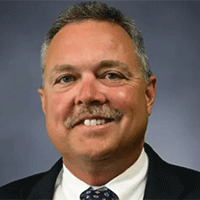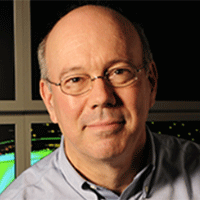Moderator: Paolo Pezzini, Ph.D., EPRI
Panelist: Rick Kephart, Emerson Electric, Co.
Panelist: Dr. David Tucker, National Energy Technology Laboratory, Department of Energy
Panelist: Dr. Kenneth Mark Bryden, Ames Laboratory, Iowa State University
Panelist: Mike Hancock, Ansys
Description: This panel session will discuss the development of digital twin and cyber-physical systems used to monitor dynamic performance operation of existing power plants and how those tools can also support the design of new integrated energy systems. The fundamental change of operating nuclear and fossil-based power plants due to the penetration of non-dispatchable resources exposed traditional power plants to aggressive electric load following operations and required the design of novel low/zero carbon technologies that can achieve high efficiency target at part-load condition. Real time models and digital twin environments with the support of cyber-physical methodologies are becoming powerful tools used to monitor performance of existing power plants but they have been also extended to design new integrated energy systems that can achieve near-zero emission targets. Regarding the monitoring of existing power plants, digital twin model supports the prompt detection of abnormal operations and the optimization of scheduled maintenance and repair services of operators, which will avoid costly forced shutdowns, thereby increasing plant availability. Regarding the design of new energy systems, digital twin and cyber-physical environments can reduce the risk of failures in the design and development of new low/zero carbon technologies. The panelists in this session will cover the state-of-the-art of digital twin systems in both areas, existing power plants and innovative cycles.

Rick Kephart
Vice President of Technology for the Power and Water Industries
Emerson
Biography: Rick Kephart has over 30 years of automation experience in the power and water/wastewater industries. Over his career he has become an expert in control systems and theory, embedded systems and real-time systems. Rick joined the organization (then known as Westinghouse Process Control) as a field engineer in 1990. He currently serves as the vice president of technology for Emerson’s power and water solutions business. In this position, Rick leads the global power and water technology organization and is responsible for shaping our technology architecture, strategy and direction for the Ovation platform and the entire power generation and water system stacks. Previously, Rick was the vice president of software solutions and responsible for managing a global organization responsible for the development of all software related to the Ovation™ automation platform. He holds a B.S. in electrical engineering from Penn State University and an M.S. in electrical engineering from the University of Pittsburgh.

Dr. David Tucker
Hybrid Performance (Hyper) Project Lead
National Energy Technology Laboratory (NETL)
Biography: His career spans research and scientific successes in industry, academia, and the government sectors. At NETL, Dr. Tucker serves as the Hybrid Performance (Hyper) project leader with research focus in cyber-physical systems, hardware-in-the-loop simulations, real-time dynamic modeling, hybrid system dynamics and controls, solid oxide fuel cell degradation, piezoelectric flow detection, high-temperature piezoelectric valves, and cyber-security using blockchain. During his tenure at NETL, Dr. Tucker developed a cyber-physical system for energy research six years before the National Science Foundation coined the term in 2008. Cyber-physical systems embody a seamless integration of hardware and numeric models that interact with a physical environment and form the foundation of intelligent systems. Using the cyber-physical approach, Dr. Tucker explored the capability of hybrid systems to maintain high efficiencies at part-load conditions and to make fast transitions to accommodate the load following required for increased penetration of intermittent renewable resources on the grid. At Jacobs Engineering Group, Dr. Tucker served as a lead engineer in piping and materials engineering on a $7.1B refinery expansion project. He taught at the University of West Alabama as a chemistry professor, performing research in the flash pyrolysis of waste biomass in high temperature plasma. As Managing Director for Southern Ventures, Inc., Dr. Tucker took the company public and led corporate direction for zero-emission conversion of waste materials into chemical products.

Dr. Mark Bryden
Program Director for Simulation, Modeling and Decision Science at Ames Laboratory
U.S. Department of Energy's Ames Laboratory
Biography: Dr. Mark Bryden is the founding director of the Decision Science program at the U.S. Department of Energy's Ames Laboratory and is a professor of mechanical engineering at Iowa State University. Dr. Bryden’s research is focused on the federation of information from disparate sources (e.g., models, data, and other information elements) to create detailed models of engineered, human, and natural systems that enable engineering decision making for these complex systems. Dr. Bryden has published more than 180 peer-reviewed articles and co-authored the textbook Combustion Engineering. He has founded two successful startups based on his research work, and he has founded the nonprofit ETHOS, a community of 150+ researchers focused on meeting the needs for clean village energy in the developing world. He has received three patents, three R&D 100 awards, two Regional Excellence in Technology Transfer awards, and a National Excellence in Technology Transfer award. In 2013 he and his coauthors received the ASME Melville Medal. The Melville Medal was first awarded in 1927 and is the highest honor for the best original technical paper published in the ASME Transactions in the past two years.
His professional experience includes three years as an engineer and 11 years as a manager at Westinghouse Electric in Idaho Falls, Idaho, and Pittsburgh, Pennsylvania. In addition, for more than 15 years Professor Bryden has worked on energy systems for the poor in a number of developing countries. Most recently he has worked in Mali, one of the poorest countries in the world, where he led an effort to develop the technology, infrastructure, and in-country support network needed to provide household lighting to remote off-grid villages.

Mike Hancock
Enterprise Director for the Department of Energy (DOE)
Ansys
Biography: Mike Hancock is the Enterprise Director for the Department of Energy (DOE) at Ansys. He leads the development and execution of strategic programs designed to help the DOE achieve its mission through transformative science and technology solutions. Before joining Ansys, Mike split his career in executive leadership roles in early-stage technology companies and large corporate environments. He has a deep background in leading-edge, sophisticated technology solutions, complex simulation, highperformance computing (HPC), data science and analytics, AI/ML, and IoT. Under his leadership, multiple pre-revenue start-ups have grown from $0 to $50M, and $100- $200M businesses have achieved consecutive years of 30-40% YOY growth in companies like IBM and Synopsys. For over 25 years, Mike has helped companies exceed their shareholder's and customer's expectations by developing and leading their sales, business development, and customer success organizations. He resides in and is a life-long native of Austin, Texas, and a graduate of the University of Texas at Austin, with a Bachelor of Science degree in Civil Engineering.